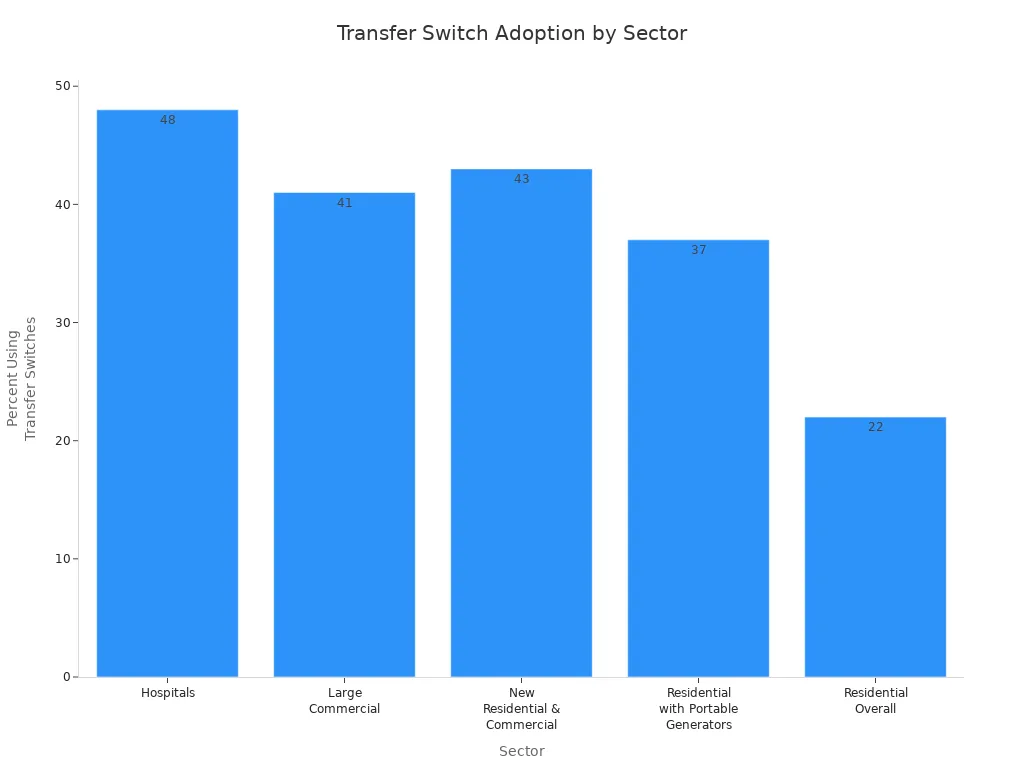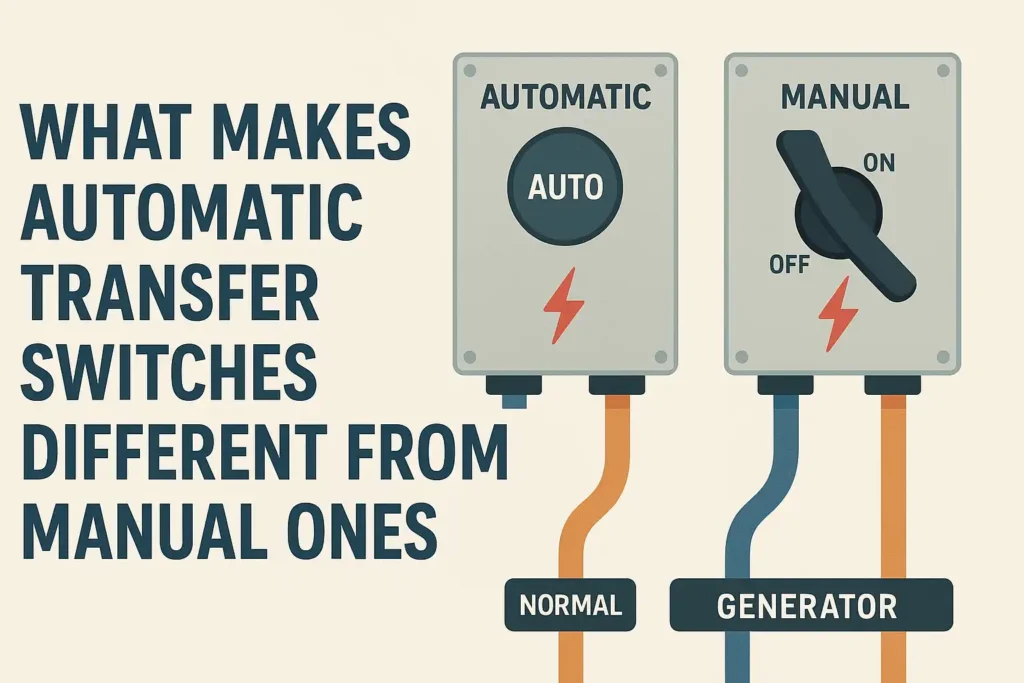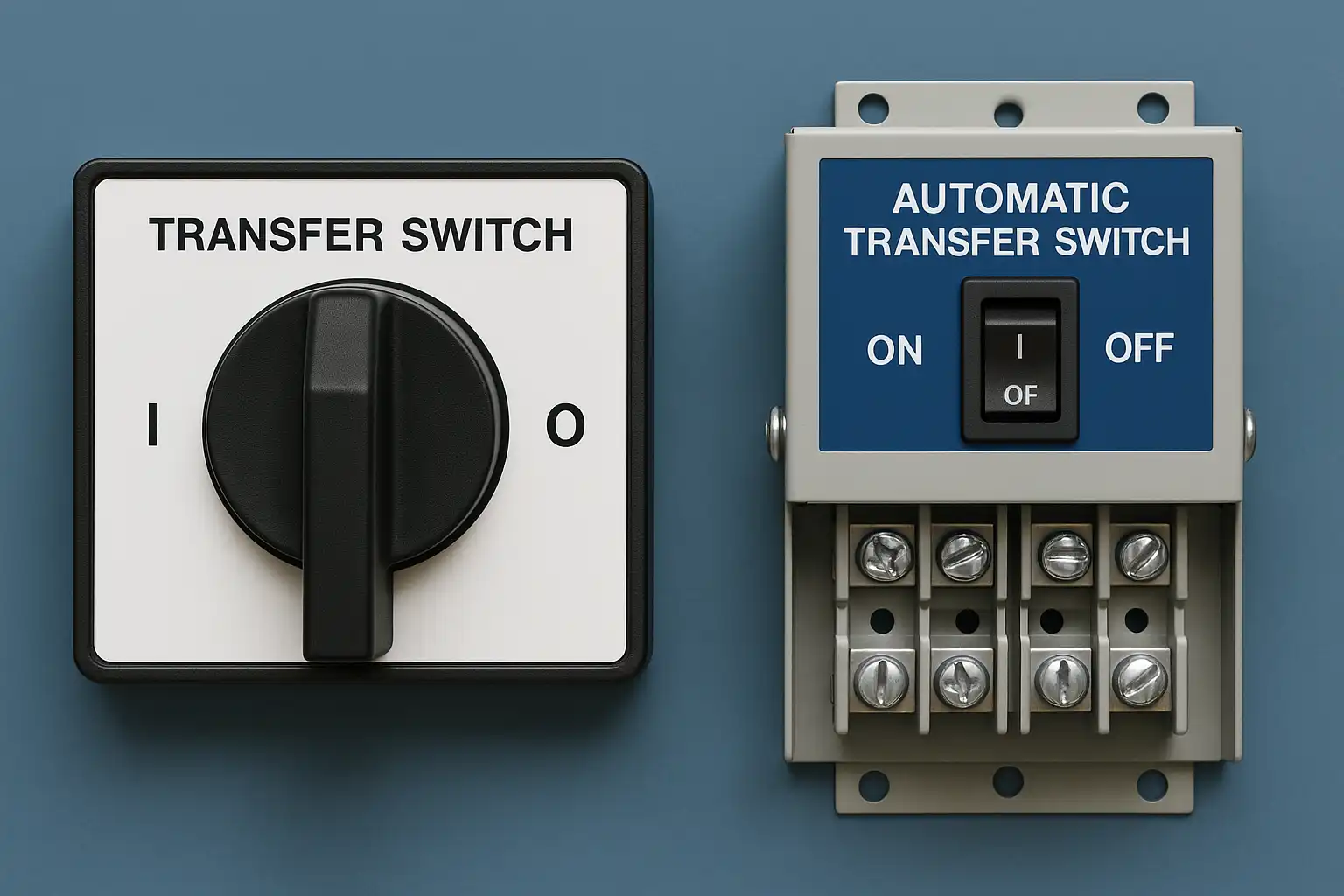The biggest difference between an automatic transfer switch and manual transfer switch is easy to spot. An automatic transfer switch will switch to backup power on its own during a power outage, while a manual transfer switch requires someone to operate it. This distinction matters because automatic transfer switches work extremely fast, often transferring power in just milliseconds. This quick response helps keep equipment running and people safe. Many hospitals, large businesses, and new buildings rely on both automatic transfer switch and manual transfer switch systems to ensure power continuity during outages:
| Sector | Percentage Using Transfer Switches | Notes |
|---|---|---|
| Hospitals | Over 48% | Use automatic transfer switch and manual transfer switch for backup energy |
| Large Commercial | Over 41% | Use automatic transfer switch and manual transfer switch for backup energy |
| New Residential & Commercial Buildings | Nearly 43% | Use automatic transfer switch and manual transfer switch to manage power |
| Residential Homeowners Using Portable Generators | Around 37% | Incorporate automatic transfer switch and manual transfer switch for secure switching |
| Residential Sector Overall | About 22% | Share of total automatic transfer switch and manual transfer switch installations |

Key Takeaways
- Automatic transfer switches move power to backup fast and do not need help. They keep important things working when the power goes out.
- Manual transfer switches need a person to turn them on. They are easier to use and cost less. This makes them good for homes and small shops.
- Transfer switches make power safe by stopping backfeeding. They also keep workers and machines safe.
- Picking the right switch depends on how much power you need. It also depends on your money, safety needs, and local rules.
- Automatic switches are best for places that must have power, like hospitals and data centers. Manual switches are good for places that do not need power all the time.
What Is a Transfer Switch?
Basic Function
A transfer switch works like a bridge for two power sources. It lets a building use either the main grid or a backup generator. In electrical engineering, a transfer switch is a device that moves all power from one source to another quickly and safely. This switch can be automatic or manual. When the main power goes out, the transfer switch notices the problem. It checks if the backup is ready. Then, it sends the power load to the backup. When the main power comes back, the switch sends the load back again.
Transfer switches use two ways to switch power: open transition and closed transition. Open transition turns off all power for a moment before switching. Closed transition lets both sources overlap for a short time. This helps protect sensitive equipment. Both ways help keep power safe and steady.
Tip: Transfer switches stop dangerous backfeeding. This keeps utility workers safe and protects equipment.
Importance
Transfer switches are very important in backup power systems. They make sure electricity only goes where it should. This keeps people and equipment safe. Without a transfer switch, hooking up a generator can cause shocks, fires, or broken appliances. Transfer switches also help people follow electrical rules.
Some main reasons transfer switches are important are:
- They let you switch safely between utility and generator power.
- They stop overloads and dangers by choosing which circuits get power.
- They protect important systems in places like hospitals and data centers.
- They make power transfers quick and easy, so there is less downtime.
Transfer switches help keep important services working. They make sure backup power can take over when needed, so essential places stay open during outages.
Automatic Transfer Switch and Manual Transfer Switch
Automatic Transfer Switch
An automatic transfer switch can tell when the main power stops. It moves the building’s power to a backup source very fast. No one needs to do anything for it to work. The switch acts in just seconds or even less. Many big buildings use both automatic transfer switch and manual transfer switch systems. But the automatic type is best for places that cannot have any power loss.
Automatic transfer switches help with important loads. These loads are things like hospital life-support, data center servers, and factory machines. The switch keeps these running by moving power right away to a backup. This protects people, data, and equipment.
Note: Automatic transfer switches are needed where losing power can hurt people or cause big problems.
The table below shows how automatic transfer switches are used in different places:
| Sector | Use Case Description |
|---|---|
| Manufacturing | Stops production lines from shutting down. This keeps machines working and saves money. |
| Office Buildings | Protects computers and security systems. This stops data loss and keeps security working. |
| Data Centers | Switches to backup power right away. This keeps servers safe and services running. |
| Healthcare Facilities | Keeps life-support and medical equipment working. This keeps patients safe when power goes out. |
Automatic transfer switch and manual transfer switch types are used for different jobs. The automatic type often switches between utility and generator, or between two utilities. For example, a data center may use an automatic transfer switch to pick between two power feeds or a generator and the grid.
Manual Transfer Switch
A manual transfer switch needs a person to work it. When the main power fails, someone must flip the switch. This connects the building to a backup generator. It takes longer than an automatic switch. But it lets the user choose when and how to switch power.
Manual transfer switches are simple and cost less than automatic ones. Many people use a manual transfer switch with their portable generators. This switch connects the generator to the house safely. It is safer than using extension cords. It also lets the user pick which circuits get power during an outage.
- Manual transfer switches are popular in homes because:
- They connect portable generators to the home’s system.
- They let people power things like fridges, lights, and sump pumps.
- They stop dangerous backfeeding and protect workers and appliances.
- They cost less to put in and take care of than automatic switches.
- They let homeowners pick which circuits get power.
Tip: Manual transfer switches come in many types. Some are for inside, some for outside. Some can power one circuit, others can power many. Homeowners can pick what works best for them.
The table below shows the main differences between manual and automatic transfer switches for small businesses:
| Feature/Aspect | Manual Transfer Switch (MTS) | Automatic Transfer Switch (ATS) |
|---|---|---|
| Initial Cost | Usually costs less at first. | Costs more because of advanced parts. |
| Installation Complexity | Easier to install and needs less work. | Harder to install and needs special skills. |
| Operation | Needs someone to switch it during outages. | Switches power by itself with no help. |
| Suitability for Small Business | Good for small businesses with simple needs. | Best for places that need power all the time. |
| Maintenance | Needs less care because it has fewer parts. | Needs more care because it is more complex. |
Automatic transfer switch and manual transfer switch choices are both important for backup power. The automatic type is best where power must always stay on. The manual type is a simple and cheaper choice for homes and small businesses.
Comparison
Operation
How a transfer switch works decides how a building gets backup power. A manual transfer switch needs a person to do each step. First, the user learns about the switch and generator. They pick which circuits to power. When the power goes out, the user starts the generator. They wait for it to run smoothly. Next, the user moves the switch from utility to generator. This disconnects the grid and connects the generator. When the main power comes back, the user switches back to utility power.
An automatic transfer switch works by itself. It senses when the power is lost. The switch moves the load to the backup source right away. No one needs to help. This happens fast and does not need anyone there. Both automatic transfer switch and manual transfer switch stop backfeed. They keep the generator and grid apart. Only the automatic type does this without a person.
Tip: Automatic transfer switches are easier to use. They cost more and have more parts than manual switches.
Response Time
Response time means how fast the switch moves power to backup. An automatic transfer switch acts almost right away. Some use special technology to switch in tiny amounts of time. This keeps power going to important things. Hospitals and data centers need this speed. Even a short power loss can cause big trouble.
Manual transfer switches take more time. The user must see the outage, start the generator, and flip the switch. This can take a few minutes. For most homes, this wait is not a big deal. For places with sensitive equipment, the wait can cause lost data or safety problems.
Safety
Safety is a big difference between the two types. Both types stop electrical backfeed. This keeps workers safe and protects the system. Transfer switches keep the generator and grid apart. This stops power from going back into utility lines. It keeps lineworkers and neighbors safe.
Automatic transfer switches have extra safety features:
| Safety Feature | Description | Safety Benefit Compared to Manual Transfer Switches |
|---|---|---|
| External Manual Operator (EMO) | Lets users work the switch without opening the cabinet | Lowers risk of shock and arc flash |
| Unidirectional Linear Motors & Over-Center Mechanism | Switches fast and safely every time | Lowers arc flash risk and contact wear |
| Microprocessor Controls with Visual Indicators | Shows clear power status | Helps users avoid mistakes and spot problems fast |
| Quick-Break Contact Mechanism | Opens and closes contacts fast with little arcing | Makes the switch last longer and stay cool |
| High-Quality Materials | Uses strong, safe parts | Makes the switch safer and more reliable |
Manual transfer switches do not have these built-in features. Users must open the box and move the switch by hand. This makes risk go up. Both types need regular checks and safe use. Never use a generator inside. Always keep the area dry.
Someone once plugged a generator into a wall outlet without a transfer switch. Power went back into utility lines. This put workers and neighbors in danger. Transfer switches stop this from happening.
Applications
Choosing between an automatic transfer switch and manual transfer switch depends on where you use it.
- Automatic transfer switches are used in:
- Hospitals and healthcare places
- Data centers
- Factories
- Large office buildings
- Important places like phone and power systems
These places need power all the time. The automatic switch keeps things running and protects devices. It also meets safety rules and cuts down on mistakes.
- Manual transfer switches are used in:
- Homes with portable generators
- Small businesses with simple backup needs
- Indoor setups where safety matters more than speed
Manual switches are good for people who want to pick which circuits get power. They cost less and are easier to put in. Some RVs use automatic switches, but these are not always safe for homes. In many small or indoor places, a manual transfer switch is the better pick.
Note: Both types stop backfeed and keep people safe. But the automatic transfer switch and manual transfer switch are best for different needs based on speed, safety, and cost.
Choosing the Right Switch
Key Factors
Picking the right transfer switch depends on many things. Every place has its own needs. It helps to look at the features side by side. The table below shows how each factor changes the choice between a manual transfer switch and an automatic transfer switch:
| Factor | Manual Transfer Switch (MTS) | Automatic Transfer Switch (ATS) |
|---|---|---|
| Cost | More affordable due to simpler design and fewer components. | More expensive because of advanced technology, sensors, and controllers. |
| Convenience | Requires manual operation; someone must be present to switch power sources. | Automatically detects outages and switches power instantly without human intervention. |
| Reliability | Simpler with fewer moving parts, less risk of component failure. | Highly reliable with automatic monitoring and switching, minimizing downtime. |
| Maintenance | Requires routine checks; may need additional backup generators during maintenance. | Requires scheduled maintenance but manages generator operation automatically. |
| Complexity | Simpler design with fewer parts, easier to maintain. | More complex due to sensors and controllers. |
| Industry Use | Suitable for less critical applications where cost savings are important. | Essential for life-safety industries like hospitals, data centers, airports where downtime can be catastrophic. |
| Criticality | Not suitable for applications requiring immediate power transfer during outages. | Ideal for critical applications needing uninterrupted power and automatic response. |
How much money you have is important. Manual transfer switches cost about $200 to $800. This makes them good for homes and small businesses with less money. Automatic transfer switches start at $1,000 and can cost more to install. Even though ATS costs more, it gives fast switching, remote checks, and automatic load control. People who need power all the time often pick ATS, even if it costs more.
Other things matter when choosing a transfer switch:
| Criterion | Explanation |
|---|---|
| Type of Transfer Switch | Manual switches need human operation and cost less, good for less critical uses. Automatic switches sense power loss and switch on their own, best for places needing constant power. |
| Capacity and Size | The switch must match the total load to avoid problems. Bigger buildings need higher capacity switches. |
| Amperage and Voltage | The switch must fit the system’s amperage and voltage for safe use. |
| Number of Circuits | The switch should cover all important circuits. Homes may need fewer circuits than businesses. |
| Compatibility | The switch must work with the generator, wiring, and electrical setup. |
| Safety Features | Look for circuit breakers, overload protection, surge suppression, and alarms. |
| Enclosure Type | Outdoor or harsh areas need weatherproof or NEMA-rated enclosures. |
| Additional Features | Surge protection, load shedding, remote control, waterproofing, and dual power inlets add extra value. |
Local rules and codes also matter. Some rules say you must use automatic transfer switches for safety. For example:
- NFPA 110 Level 1 systems need automatic transfer switches for safety.
- NEC Articles 700, 701, and 708 say to use automatic switches for emergency and important power.
- Some local rules want closed transition switches with special relays for safety.
- Enclosure types must be safe for outdoor or tough places.
Tip: Always check local rules before buying a transfer switch. This makes sure your system is safe and legal.
Automatic transfer switches and manual transfer switches work in different ways. They are not the same for safety or how easy they are to use. The table below shows how they are different:
| Feature | Automatic Transfer Switch (ATS) | Manual Transfer Switch |
|---|---|---|
| Mode of Operation | Switches by itself | Needs a person to switch it |
| Safety | Safer, less chance of mistakes | Less safe, user must do the work |
| Cost | Costs more money | Costs less money |
| Suitability | Good for hospitals and big buildings | Good for homes and saving money |
Picking the best switch depends on what you need for power. You should also check if your generator works with the switch. Safety is very important too. Experts say to look at how much power you need. Use a weatherproof box if the switch is outside. Always follow local rules. People sometimes make mistakes by picking a switch that is too small. Some forget to check if the switch and generator work together. Automatic switches are best for places that always need power. Manual switches are fine for homes or places that do not need fast backup.
FAQ
What does a transfer switch do during a power outage?
A transfer switch sends power from the main source to a backup generator. This helps keep lights and appliances on when the main power stops.
What makes an automatic transfer switch safer than a manual one?
An automatic transfer switch works by itself. It lowers the chance of shock or mistakes. This switch has safety features that protect people and equipment.
What types of buildings need automatic transfer switches?
Hospitals, data centers, and factories use automatic transfer switches. These places cannot lose power. The switch keeps important systems working and protects equipment.
What should a homeowner consider before choosing a transfer switch?
A homeowner should think about power needs, budget, and generator type. They also need to check local electrical codes. Safety and easy use are important for home setups.
The following information may be of interest to you
Transfer Switch vs Automatic Transfer Switch: Key Differences
Manual or Automatic? Decide on Your 200 Amp Transfer Switch
How a Solar ATS Improves Solar Power Reliability
Benefits of Installing an ATS for Household Backup Power


Automatic-transfer-switch-products.webp)
Latest-automatic-transfer-switch.webp)


